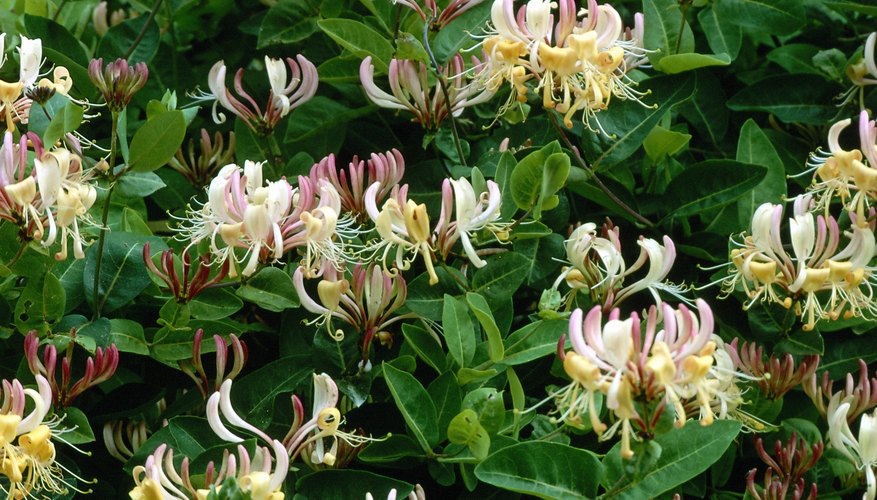Bearing beautiful, fragrant summer flowers, honeysuckle vines (Lonicera spp.) scramble over fences, trellises and other garden structures. Usually easy to care for, honeysuckles with yellow leaves with black spots could be suffering from a number of conditions, including nutrient deficiency, the fungal disease, rust, or a pathogen new to the UK, honeysuckle leaf blight. Honeysuckle vines are robust plants when growing in suitable conditions.
Nutrient deficiency
Honeysuckles that develop yellow leaves could be suffering from nutrient deficiency. Low levels of nitrogen, potassium, phosphorous or magnesium, cause poor growth and yellow leaves, sometimes with brown areas. Applying fertiliser, such as chemical fertilisers, well-rotted manure, blood and bone or other organic fertilisers, helps correct nutrient deficiencies, but plants must be growing in good conditions. Dry or waterlogged plant roots, and those growing in excessively acidic or alkaline soils, struggle to take up nutrients.
- Honeysuckles that develop yellow leaves could be suffering from nutrient deficiency.
- Applying fertiliser, such as chemical fertilisers, well-rotted manure, blood and bone or other organic fertilisers, helps correct nutrient deficiencies, but plants must be growing in good conditions.
Rust
Rust, a common fungal disease, affects many garden plants such as honeysuckle vines, causing brown, black, white, yellow or orange spots. Badly-affected leaves turn yellow and die. Its pustules produce spores that overwinter on plants and fallen leaves, reinfecting plants the following year. Picking off leaves bearing the first signs of disease helps control outbreaks, but plants suffer from removal of large numbers of leaves. For severe attacks, spray with a fungicide such as difenoconazole or myclobutanil. Fertilising vines does more harm than good, as rust thrives on new, soft, sappy growth.
- Rust, a common fungal disease, affects many garden plants such as honeysuckle vines, causing brown, black, white, yellow or orange spots.
- Picking off leaves bearing the first signs of disease helps control outbreaks, but plants suffer from removal of large numbers of leaves.
Honeysuckle leaf blight
First observed in the UK in 2000, honeysuckle leaf blight (Insolibasidium deformans) is an introduced disease that causes yellow leaves in spring that turn brown as the season progresses. Leaf undersides are silvery-white, and leaves often become twisted or curled and fall prematurely. Honeysuckles grown in areas with poor air circulation are particularly susceptible as the disease flourishes in high humidity. Plants in the south of England are most at risk. Removing affected foliage at the first sign of infection, and taking care not to wet foliage when watering, helps control the disease.
- First observed in the UK in 2000, honeysuckle leaf blight (Insolibasidium deformans) is an introduced disease that causes yellow leaves in spring that turn brown as the season progresses.
Care
Well-grown honeysuckle vines are least susceptible to nutrient deficiencies and disease. They grow best in well-drained, humus-rich soil, such as soil mixed with compost, leaf mould or well-rotted manure. Ideally, the base of the plant sits in shade and the top growth receives full sun. Feed plants in spring with a general purpose fertiliser, then mulch to a depth of 7 cm (3 inches) to help conserve moisture. Don't place mulch directly next to plant stems as this can cause rotting. Late-flowering honeysuckle vines should be thinned in early spring, removing weak and damaged stems. Early-flowering honeysuckles should be cut back by one-third in late summer.
- Well-grown honeysuckle vines are least susceptible to nutrient deficiencies and disease.
- Late-flowering honeysuckle vines should be thinned in early spring, removing weak and damaged stems.
